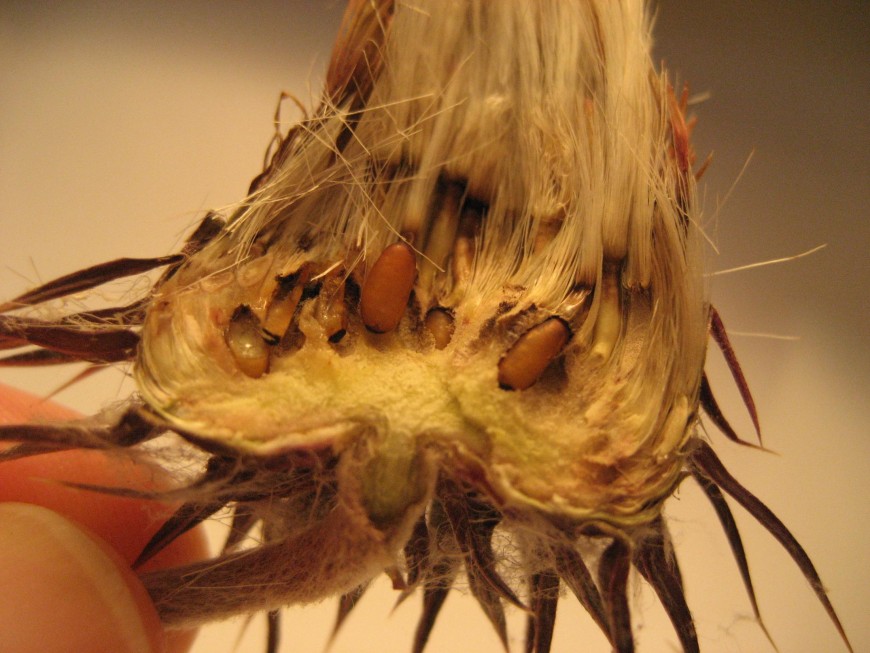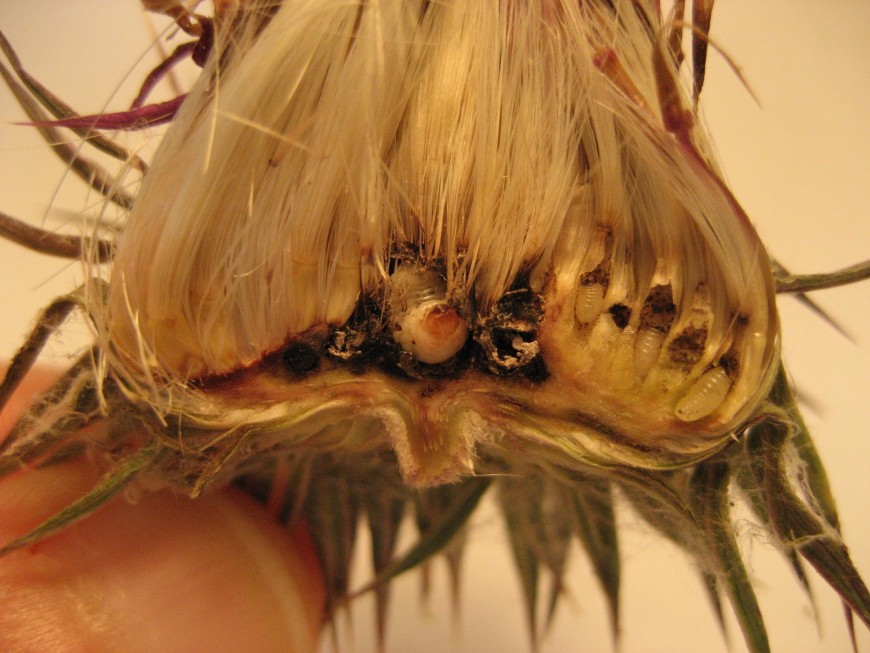Nodding thistle gall fly
History in New Zealand
Nodding thistle gall flies are native to Europe, and they were first imported from Austria by the DSIR in 1989. The gall flies were introduced to complement the activity of nodding thistle receptacle weevils which successfully destroy many seeds produced by early flowers, but are less successful on later flowers. Because of difficulties rephasing the Austrian gall flies to Southern Hemisphere conditions, Manaaki Whenua - Landcare Research imported an additional French strain in 1992. These gall flies were imported from Australia where they are also being used as a biocontrol agent. The gall flies were mass reared and released widely during the early 1990s. As a result, the gall flies are established and becoming widespread in both the North and South Islands.
How would I find/recognise it and what is its lifecycle?
Look for adult gall flies during summer and autumn. The adults have black bodies, distinctive black stripes on the wings, and are about 5–8 mm long. You may see them flying about or sitting on thistle flower heads. You will not be able to see the eggs as the females use their long black ovipositors to lay eggs inside the green flower buds. Nodding thistle flower heads are made up of hundreds of individual flowers, and the females lay their eggs one at a time inside each flower (or floret). Tests have shown that each female can lay about 100 eggs.

Image: nodding thistle gall fly (Urophora solstitialis). Photo credit: c Jacob Littlejohn CC BY SA.
Image: nodding thistle gall fly.
The creamy-white larvae hatch and burrow their way into the receptacle (the part of the flower that supports and nourishes the developing seeds). Larval feeding makes the plant produce gall tissue around each larva. If several larvae are feeding inside the same flower head, then the individual galls fuse to form one large gall. The larvae feed on the tissue on the inside of the gall and develop at the expense of the surrounding seeds.

Image: nodding thistle gall fly larvae.
First generation larvae feed for about 5 weeks and then remain as prepupae until the flower head matures, before pupating inside the galled flower head. The new adults emerge and begin a second generation, provided suitable flower heads are available. Second generation larvae remain as prepupae inside the flower heads throughout the winter and emerge as new adults the following spring.

Image: nodding thistle gall fly pupae.
You can identify infested flower heads using the following method: Look for mature, dried flower heads that still have shiny white pappus hairs attached to them. Carefully pick them off the plant and pinch the centre of each one between your thumb and forefinger. If it feels hard and lumpy then the flower head is infested, otherwise it will feel smooth and flat. Attempt to break the flower head open – this should prove difficult and you will need a knife to reveal the yellowish chipboard-like interior containing gall fly larvae. If the flower head is easy to break open and looks black inside, then it is infested with the nodding thistle receptacle weevil. You may also find flower heads that are infested by both agents and show some of the characteristics of each.

Image: nodding thistle crown weevil larva (large grub on the left) and gall fly larvae (smaller maggots on the right) in a nodding thistle flower head.
The gall fly adult is also easy to differentiate from the nodding thistle crown weevil.
See Nodding thistle crown weevil, Nodding thistle receptacle weevil.
How does it damage nodding thistles?
The larvae are the damaging stage whith each one destroying about 6 seeds. A large flower head may support as many as 60 larvae, but more commonly 20–40.
Image: nodding thistle flower heads damaged by gall fly larvae.
Image: nodding thistle flower heads damaged by gall fly larvae.
Will it attack other plants?
The gall flies may attack other Carduus thistles, but strongly prefer nodding (Carduus nutans) and plumeless thistle (Carduus acanthoides). Other plants are not thought to be at risk.
How effective is it?
The impact of the gall fly has only been measured in Canterbury and found they were only able to destroy about 8% of total seed production. The gall flies were being adversely affected by nodding thistle receptacle weevils early in the season, which was limiting their effectiveness later in the season. The impact of the gall fly in other parts of New Zealand is unknown but it is likely to vary from place to place and from year to year.
How can I get the most out of it?
The gall fly is widespread and is present in all areas where nodding thistle is a pasture weed. If the gall flies are not present in your area, you can shift some from a well-established site.
How do I select a release site?
Read Guidelines for selecting release sites for biocontrol agents.
How do I collect it for release at other sites?
Look for infested flower heads once they have dried off in the autumn. You will need to release 50–100 flower heads at each new site and you should leave at least 100 flower heads at your collection site. Use secateurs, or simply thick gloves, to cut or pull the infested flower heads off the plants. We recommend that you put the flower heads in an onion bag or similar (strong enough to last the winter, that has holes in it large enough to let the flies get out in the spring but is not so large that the flower heads fall out.
Divide your flower heads up amongst several bags and securely tie them up off the ground (where mice cannot get them) in a shady area – if temperatures get too hot, the larvae inside the flower heads can be killed. The flies should begin to emerge from the bags once the thistles are beginning to produce flower buds in late spring.
How do I manage the release sites?
Avoid activities that will interfere with the gall fly’s life cycle. Avoid mowing thistles before the flower heads have dried off in autumn, as you are likely to kill both the gall fly and the receptacle weevil. Also, avoid overstocking, as hungry animals may eat all the flower buds. During times of extreme drought, you may need to fence off a patch of thistles to protect them. If you need to use additional control methods on your thistles, then spray the rosette stage over winter when the seed-feeding agents will not be affected. However, avoid spraying the rosettes if you have nodding thistle crown weevil present.
If you have had difficulty establishing the gall fly, then you may wish to try accelerating their emergence. The gall flies have to compete with the receptacle weevil for the first primary flowers so they are more likely to survive if they get a head start. Collect the flower heads as above and then store them inside paper bags in a fridge or cool store. Remove the flower heads from the fridge in early-mid October and store them in a warm place for 2 weeks before putting them out at a release site in an onion bag or similar.

